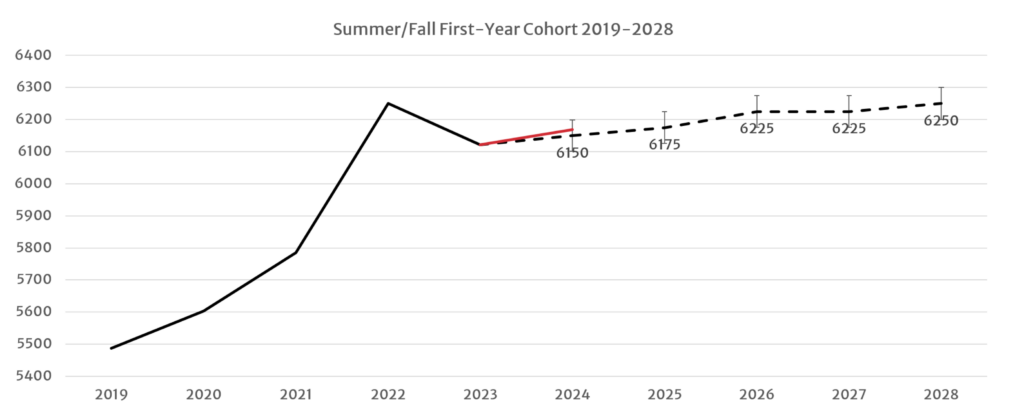The goal of enrollment management at the University of Georgia is to define and attain the desired student body that will enable the University to achieve its mission. The University seeks to maintain a balance between its enrollment and the resources necessary to support that enrollment. Where growth is desired, the University will pursue responsible growth.
The University of Georgia has launched its Strategic Enrollment Management Plan 2024-2028 in response to the record number of applicants in recent years. The University of Georgia’s ability to grow enrollment is limited by campus resources in Athens rather than by limited interest from students. This strategy recommends moderating on-campus undergraduate enrollment to allow for campus resource capacity to better accommodate market demand.
This plan is centered around a 1.5% average growth in enrollment combined with the hiring of 115 additional tenure-track faculty over the next five years.
 The 2024-2028 plan highlights five goals:
The 2024-2028 plan highlights five goals:
- Sustain the size, residency, and academic profile of the first-year cohort
- Enroll one new transfer for every two first-year students
- Increase graduate enrollment in high-demand programs
- Increase faculty hiring corresponding to increases in student enrollment
- Improve economic and social mobility of graduates
View the enrollment management plan in its entirety here: Strategic Enrollment Management Plan 2024-2028
1 – First-Year Enrollment
The plan recommends moderating the growth of the first-year class over the next five years, increasing the first-year cohort by 0.5% each year. This will ensure a high-quality student experience that remains within the bounds of campus and community resources.
UGA will maintain its commitment to delivering an exceptional on-campus experience. Online options for undergraduates will be limited to the Summer term.
Enhancing campus infrastructure is also key, and housing, parking, and dining are the primary limitations to growing on-campus enrollment. Plans are already underway to construct new parking facilities, projected to be completed in the fall of 2025, and a new residence and dining hall, both of which are on track to be ready in the fall of 2026.
2 – Transfer Enrollment
Approximately 95% of transfer students live in Georgia, and they are twice as likely to be the first in their family to graduate with a bachelor’s degree. One plan to reach these students is to expand the Transfer Pathway program, which allows students who were waitlisted as first-year applicants to apply a semester earlier than traditional transfer students.
UGA can increase transfer enrollment by removing barriers in the admission process and implementing best practices for transfer students, especially among academic programs with capacity to grow. The goal is to enroll one transfer undergraduate student for every two first-year students enrolled, and this modest increase will help to stabilize overall undergraduate enrollment growth by approximately 1% each year.
3 – Graduate Enrollment
By offering high-quality, online graduate programs, UGA will be better able to serve citizens in the state of Georgia. This plan recommends expanding UGA’s online graduate programs in high-demand areas, which will offer a high-quality alternative to those currently being offered by out-of-state, for-profit universities. This approach is projected to increase graduate enrollment by 4% annually.
This plan calls for investment in a venture fund to create new online programs and expand ancillary staffing to support growth of online programs. It will also expand the Office of Online Learning’s mission to include quality enhancement for existing online programs.
4 – Faculty Resources
Moderating undergraduate enrollment growth and increasing online graduate enrollment will require new investments in instructional faculty in order to support UGA’s market position and provide an outstanding educational experience for students. Therefore, over the next five years, UGA will hire 115 tenure-track faculty to ensure instructional faculty keeps pace with enrollment growth.
To ensure UGA continues to deliver an excellent educational experience, this report recommends maintaining a 17:1 student-to-faculty ratio.
This plan will address competitive market rate and salary compression among tenure-track faculty positions. UGA will hire additional non-tenure-track and staff positions to support overall enrollment growth as well.
5 – Economic and Social Mobility
As the measures of quality in higher education shift and new data becomes available, it is imperative for UGA to continue providing an outstanding student experience from the initial point of contact to a successful post-graduation future. This includes a focus on the experiences and career outcomes of first-generation and low-income students.
According to U.S. News calculations, the six-year graduation rate for UGA students who are the first in their family to attend college is 74%, compared to 79% for non-first-generation students.
This Strategic Enrollment Management Plan calls for systematic attention to outcomes for first-generation, low-income, and transfer students. By expanding holistic financial support and aligning need-based initiatives, reducing barriers to time-to-degree for first-generation and transfer students, and expanding graduate program pathways to assist low-income students, UGA can reduce graduation and completion gaps for low-income, first-generation and transfer students.
View the enrollment management plan in its entirety here: Strategic Enrollment Management Plan 2024-2028
Please contact Andy Borst, vice provost for enrollment management, at borst.uga.edu with any questions about the Strategic Enrollment Plan.









